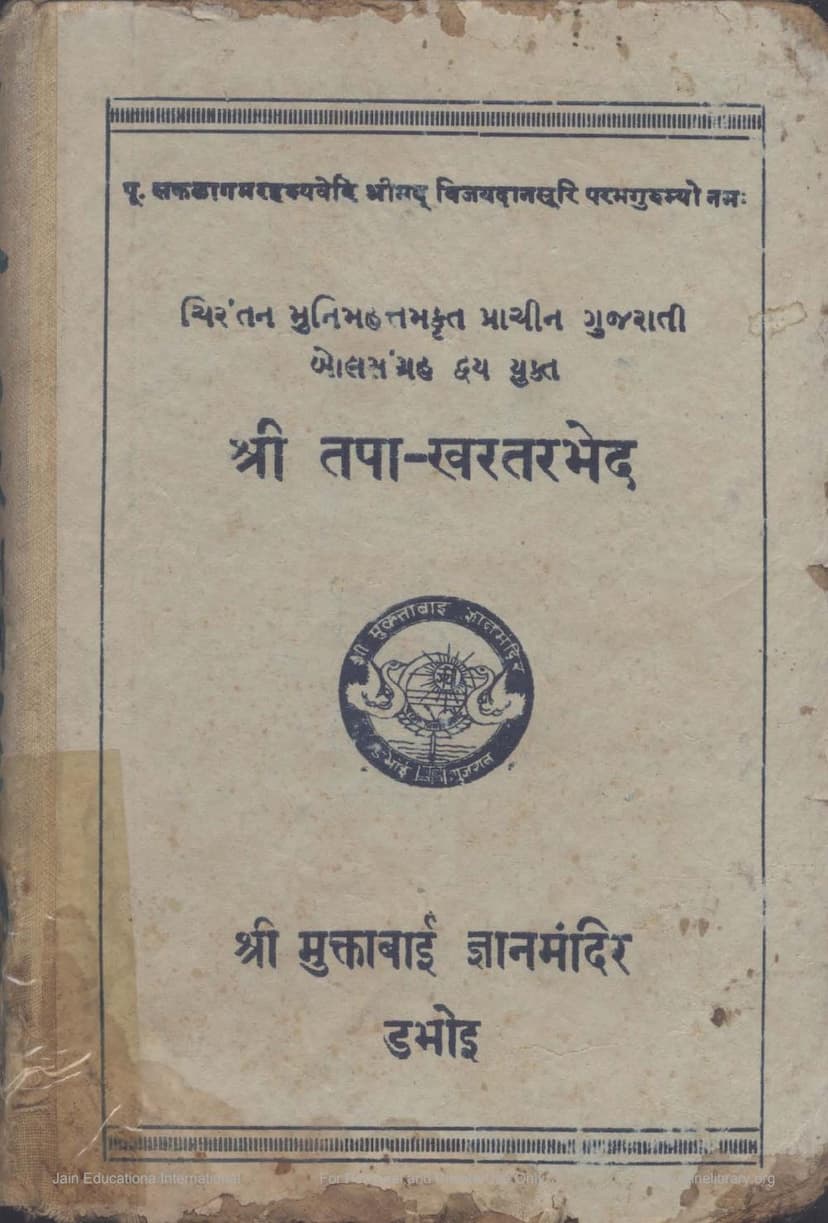Tapa Khartar Bhed
Added to library: September 2, 2025

Summary
This Jain text, titled "Tapa Kharatar Bhed" (Revealing the Differences between Tapa and Kharatar sects), authored by Vijay Jambusuri and published by Muktabai Gyanmandir Baroda, is a comparative study of the practices and beliefs of two prominent sub-sects within the Tapa Gachha tradition of Jainism: the Tapa Gachha and the Kharatar Gachha.
The book aims to clarify the distinctions between these two groups, noting that over time, some Kharatar Gachha practices have inadvertently entered the Tapa Gachha. It presents itself as a necessary guide for the Jain populace to understand and address these deviations, offering evidence from ancient texts and authoritative sources.
Key aspects highlighted in the text include:
- Content Structure: The book contains two "Balsangrahas" (collections of points or issues), with the first detailing 141 differences and the second detailing 161 differences.
- Purpose: The primary goal is to differentiate the beliefs and practices of the Tapa and Kharatar Gachhas, especially concerning points where the Kharatar Gachha's practices are perceived to have influenced or deviated from the Tapa Gachha's established traditions.
- Methodology: The text systematically lists and explains numerous points of divergence (referred to as "Bols" or "Bhed"). These points cover a wide range of religious observances, philosophical interpretations, and practical guidelines.
- Specific Differences Highlighted: The text enumerates numerous differences, often starting with how the Tapa Gachha practices something and then contrasting it with the Kharatar Gachha's approach. These include:
- Kalyanaks (auspicious events): Differing views on the number of auspicious events for various Tirthankaras.
- Worship: Restrictions or permissions regarding worship by women.
- Samayika (meditation): Specifics of reciting mantras during Samayika.
- Pausadha (fasting): Rules regarding eating during Pausadha, including night Pausadha.
- Offerings and Rituals: Practices related to making offerings, worshiping deities, using specific ritual items like a rajoharan (broom), and observing the "Yugpradhan" concept.
- Timekeeping and Calendar: Differences in determining auspicious days and managing intercalary months.
- Dietary Rules: Variations in accepting or rejecting certain types of food, especially during specific observances.
- Conduct of Monks and Nuns: Rules regarding their behavior, interactions, and specific rituals.
- Interpretation of Scriptures: Divergent interpretations of scriptural passages related to various practices.
- The Role of Authorities: The veneration and adherence to the teachings of specific gurus and Acharyas from each lineage.
- Daily Rituals: Differences in morning and evening prayers, recitations, and other daily observances.
- Specific Practices: The text goes into granular detail about various practices, such as the number of times to recite certain mantras, the specific phrasing of prayers, the manner of conducting rituals, and the adherence to certain traditional practices versus newer interpretations.
- Criticism of Kharatar Gachha: The text often implies or directly states that certain practices of the Kharatar Gachha are deviations from the original scriptures or traditions, are self-invented ("manakalpi"), or are influenced by non-Jain customs.
- Praise for Tapa Gachha: Conversely, the Tapa Gachha's adherence to established traditions and scriptures is implicitly or explicitly presented as correct.
- Historical Context: The preface mentions that the original manuscript was written around the 17th century, with references to events and dates from that period, indicating the historical context of the differences being discussed.
- Editorial Notes: The text includes editorial notes and clarifications, often enclosed in brackets or indicated by question marks, to explain the meaning of ancient Gujarati or to highlight discrepancies.
- Corrective Approach: The book seems to advocate for a return to the established Tapa Gachha practices, urging for the correction of perceived deviations that have been introduced.
- Call to Action: The concluding remarks express hope that readers will benefit from this "excellent publication" and requests forgiveness for any errors. It also thanks those who financially supported the publication.
In essence, "Tapa Kharatar Bhed" serves as a detailed scriptural and practical reference, aiming to preserve the purity of the Tapa Gachha's traditions by meticulously outlining and contrasting them with those of the Kharatar Gachha, highlighting the perceived deviations and advocating for adherence to the former.